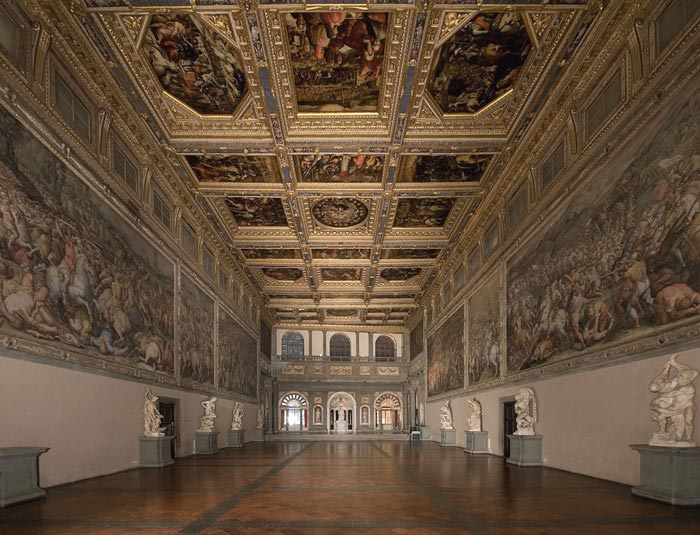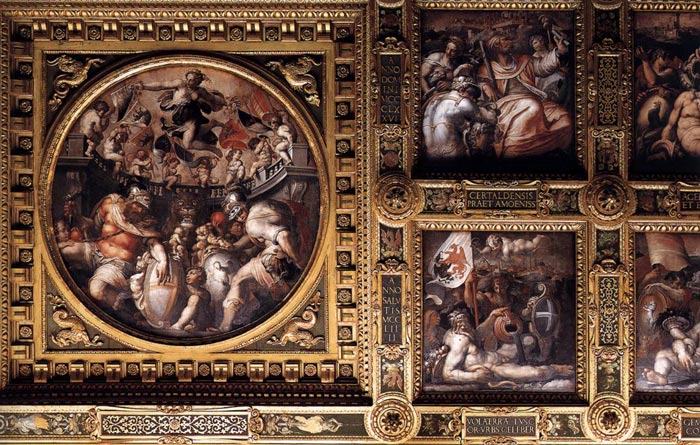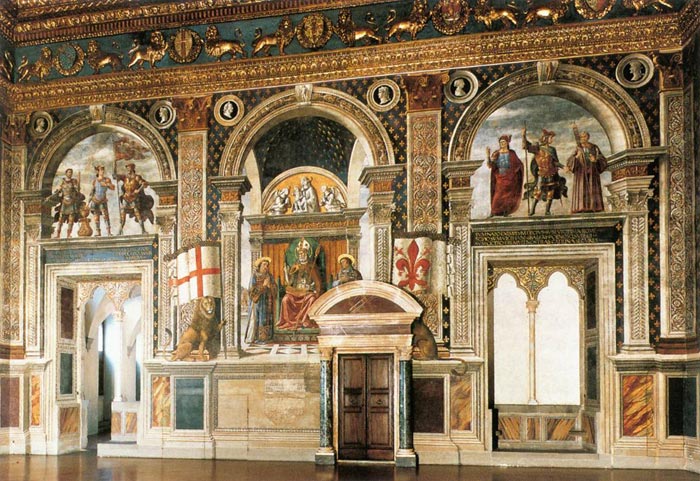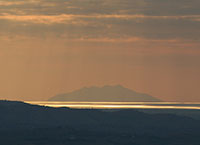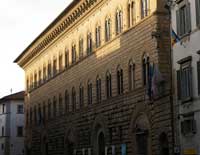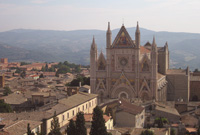| |
|
| |
|
|
|
|
|
|
| |
 |
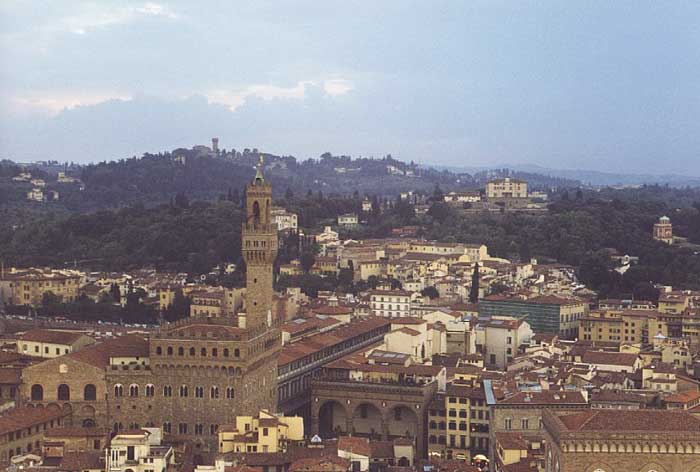 |
|
 |
 |
Palazzo Vecchio in Florence
|
|
 |
 |
| |
|
|
|
| |
|
Tuscany Travel Guide | Art in Florence | Palazzo Vecchio in Florence
|
|
|
|
| |
|
Palazzo Vecchio is the heart of Florentine civil life. Built at the turn between the 13th and 14th centuries as the seat of the Priors, the oldest part of Palazzo Vecchio was originally designed by Arnolfo di Cambio (1245-1302). The later additions of the 15th and above all of the 16th centuries changed the scale of the rear part of the palace, without however modifying the massive appearance of the huge blocks, projecting gallery and asymmetrical tower.[0]
|
Various statues are lined up in front of the Palazzo Vecchio, including a copy of Michelangelo's David, that replaced the original in 1873, and the group of Hercules and Cacus by Bandinelli. On the facade, above the door, there is a medallion with the monogram of Christ betweer two lions in a blue field, surmounted by a gable. The inscription" Rex regum et Dominus dominantium" was placed there in 1551 by order of Cosimo I, to replace the previous inscription, set there thirty years before.
Initially, the seat of the Signoria was provisionally used by the Grand Ducal family until 1540 when Cosimo I de Medici moved the residence to the newly built Palazzo Pitti (it was at that time that the palace was referred to as "old"). The transformations applied by Vasari date back to this period (1550-65). He sumptuously redecorated the newly reconstructed interiors taking into account the new role of the palace, which was to be used both as seat of the gouvernement and as official residence of the ruling family (the so-called Monumental Quarters). The most important rooms of the palace are illustrated in sequence. The first entrance courtyard with white and gilded stucco work, redecorated with frescoes in the 16th century, owes its elegant structure to the second half of the 15th century. The courtyard opens on to the ancient Armoury now frequently used by the Town Council to organise exhibitions.
On the first floor we find the grandiose Salone dei Cinquecento, a work by Cronaca (1495), which was used for the assemblies of the General Council of the People, after the State reforms brought about by Girolamo Savonarola. The walls of the hall, originally decorated by Michelangelo and Leonardo, owe their present-day monumental appearance to Vasari and his pupils and date back to the second half of the 16th century. The panelled ceiling, the frescoes on the walls, the Udienza (the raised section of the room with statues by Bandinelli and Caccini), the sculptures of De Rossi featuring the Deeds of Hercules contribute to the complex and rich symbolism and offer a precise historical view of the glorious past of the Medici family. The hall also exhibits the Genius of Victory by Michelangelo. In contrast with the grandness of this hall, but equally sumptuous is the little Studiolo of Francis I, a jewel of Mannerism art and sensitivity, where the prince retired to meditate and gaze his treasures (about 1570).
The visit can continue through the rooms on the first floor, each dedicated to a personality of the Medici family (Cosimo the Elder, Lorenzo, Leo X), all appropriately frescoed.
On the second floor we find the "Quarter of the Elements" and the apartments of Eleonora da Toledo, the wife of Cosimo I. Despite the rich overall decoration, it is worth admiring the small chapel of the princess that was magnificently decorated by Bronzino (1503-1572). The visit can continue through the official rooms, like the Audience Chamber and the Lily Chamber with sumptuous ceilings, decorations and doors dating back to the 15th century. The final section of the monumental apartments preserves the Loeser Collection, donated to the Town of Florence by the American art critic Charles Loeser, who died in 1928. The collection includes paintings and sculptures of the Tuscan school ranging from the 14th to the 16th centuries (works by Tino da Camaino, Berruguete, Rustici, Bronzino and Cellini).
To the right of the main entrance to the Palazzo Vecchio, across the statue of Hercules and Caco, one can see a carved face of a man, called L'Importuno. Legend has it that when Michelangelo passed through the Piazza della Signoria, he was often stopped by a man who would bother (importunare) and speak nonsense to him. One day, while he passed by via della Ninna, Michelangelo was met by this bothersome chatterbox. He happened to have his mallet and chisel in hand, and so, with his back against the wall of the Palazzo Vecchio, and his hands behind his back, he chiseled an image of the man into the stones while he spoke. For centuries Florentines have called this chiseled profile l’Importuno — “the intrusive one.”
|
|
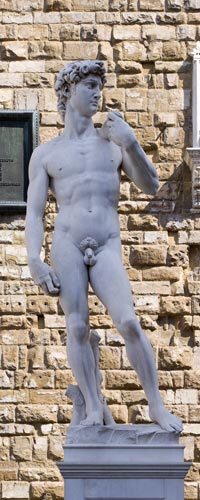
Replica of the David front of Palazzo Vecchio
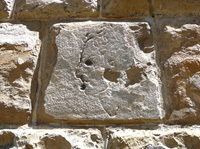 Michelangelo, L'Importuno Michelangelo, L'Importuno
|
Palazzo Vecchio, Piazza Signoria - Firenze
Opening Hours. Weekdays: 9 am - 7 pm; Thursday 9 am - 2 pm;
the ticket office closes 1 hour before the museum closing time.
Holidays: Sundays 9 am - 7 pm Midweek holidays 9 am - 2 pm (January 6, Easter Monday; April 25; June 2; November 1; December 8 and 26); the ticket office closes 1 hour before the museum closing time
Closed on: December 25, January 1, Easter, May 1, August 15.
|
|
|
|
|
|
| |
|
|
|
|
La Piazza della Signoria
|
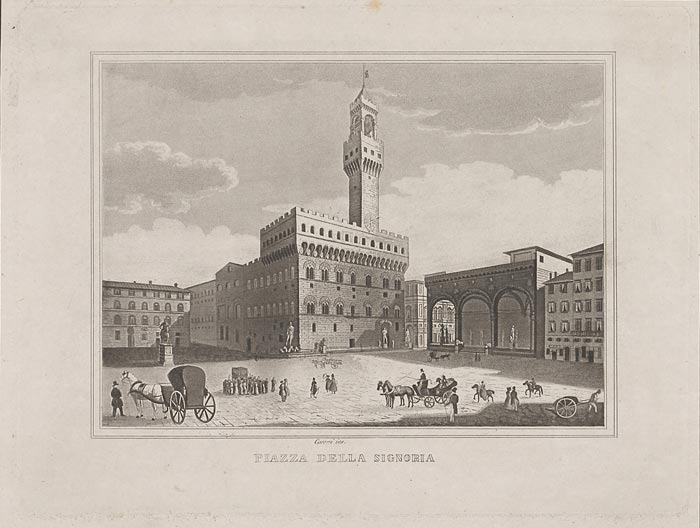 |
Giuseppe Carocci (engraver): View of the Piazza della Signoria, first half of the 19th century, lithograph, 19.5 x 25.9 cm
[Kunsthistorisches Institut in Florence] (1)
|
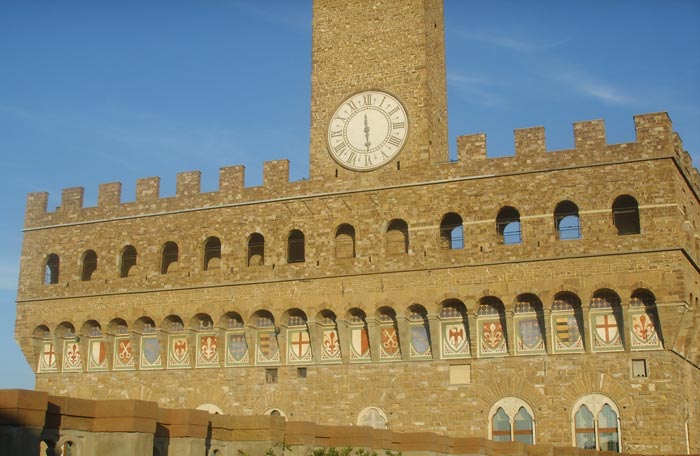 |
Medieval coat of arms in stone wall recess, Palazzo Vecchio Florence, view from the Loggia dei Lanzi terrace
|
The Loggia della Signoria | The Loggia dei Lanzi
|
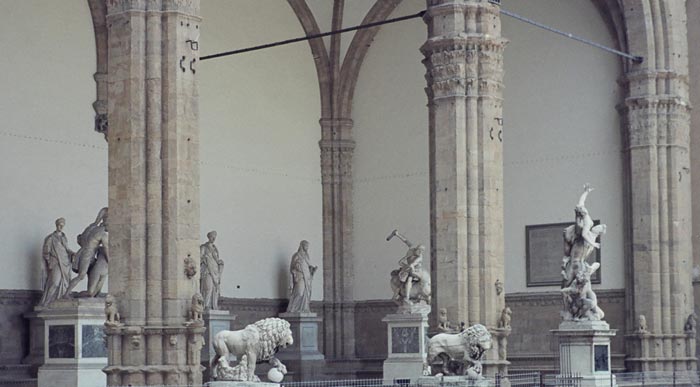 |
|
The Loggia dei Lanzi is an arched gallery that was built in the 14th century in front of the Palazzo Vecchio. The original purpose of the gallery was to shield dignitaries from the elements during ceremonies, public meetings and events. Today it houses a number of statues, the most notable being a statue showing Perseus after he killed Medusa.
The loggia with three large arches was built between 1376 and 1382 by the Florentine architect Simone di Françesco Talenti and the Lombardian-born architect Benci di Cione Dami. The beautifully proportioned open gallery was designed in a late gothic style, a clear precursor to the soon to be popular Renaissance style. Michelangelo, one of the most prominent Renaissance artists, even proposed to extend the gallery along all sides of the Piazza della Signoria, but Cosimo I de' Medici, Duke of Florence, eventually decided it would be too expensive.
Art in Tuscany | The Loggia della Signoria | The Loggia dei Lanzi |
|
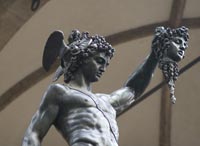
The statue of Perseus by Cellini depicts a decapitation that was intended as a warning to enemies of Cosimo I
|
Hanging and burning of Girolamo Savonarola in Piazza della Signoria in 1498
|
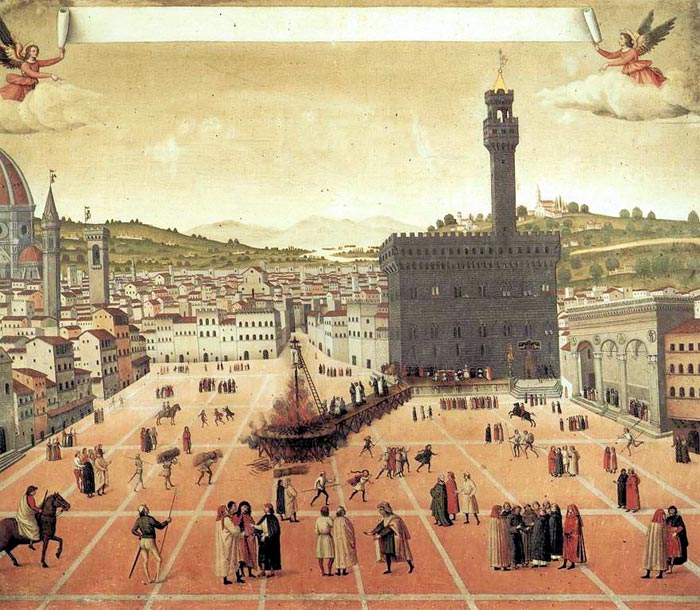 |
Hanging and burning of Girolamo Savonarola in Piazza della Signoria in Florence in 1498, attributed to Francesco di Lorenzo Rosselli, Museo di San Marco, Florence
|
Girolamo Savonarola was a Ferrarese Dominican friar who preached in Florence between 1490 and 1498. He gained support among the nobles and ruled Florence briefly after the removal of the Medici, but was ultimately abandoned by Florentines after he failed to prove himself chosen by God via trial by fire. After oppressive months of violence and the bonfires of the vanities, pope Alexander VI excommunicated him and placed the city under a trade embargo. He was burned for inciting schism and heresy - claiming to be the voice of God. On the day of his execution he was taken out to the Piazza della Signoria along with Fra Silvestro and Fra Domenico da Pescia. The three were ritually stripped of their clerical vestments, degraded as "heretics and schismatics", and given over to the secular authorities to be burned. The three were hanged in chains from a single cross and an enormous fire was lit beneath them. They were thereby executed in the same place where the Bonfire of the Vanities had been lit, and in the same manner that Savonarola had condemned other criminals during his own reign in Florence.(2)
|
Eleonora di Toledo’s Rooms
Cosimo I’s wife had a suite of rooms decorated with scenes of virtuous women. Penelope, wife of the Greek hero Odysseus, is shown waiting faithfully for her husband to return.
|
Bronzino's Chapel of Eleonora
|
In 1540, soon after marrying Eleonora of Toledo, Cosimo de' Medici moved from the Palazzo Medici into the Palazzo della Signoria, publicly proclaiming his dominance over all civic institutions. Cosimo remodeled the building to accommodate his expanding family and commissioned elaborate decorative programs of the histories of his ancestors, of his own military conquests, and of dynastic portraiture to fill its vast spaces. On the upper floor Cosimo constructed a small cubical chapel for Eleanor's private devotions, completely decorated by Agnolo Bronzino with imagery that ostensibly referred to Christian redemption but which barely veiled his dynastic and political intentions.
|
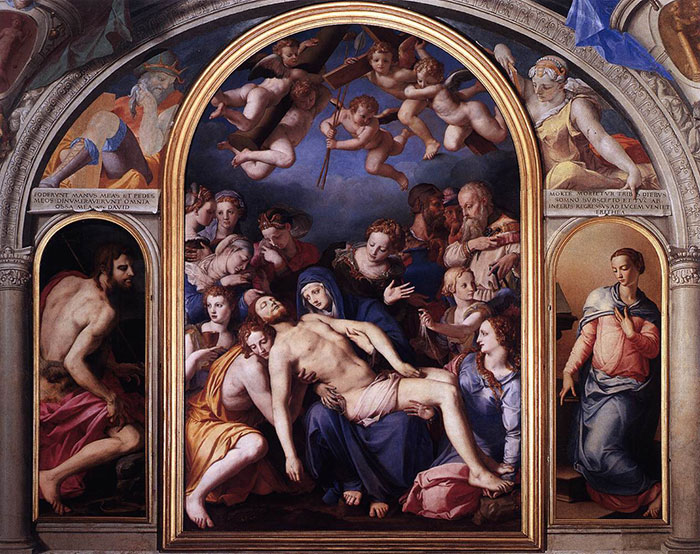 |
Agnolo Bronzino, Altarpiece, c. 1540, oil on wood, Palazzo Vecchio, Firenze
This image is a digital reconstruction of the probable original appearance of the altar wall of the Cappella di Eleonora in the Palazzo Vecchio, Florence, with Bronzino's first version of the Lamentation (oil on wood, 268 x 173 cm, now in the Musée des Beaux-Arts, Besançon) and his John the Baptist (oil on wood, 147 x 52 cm, now in the J. Paul Getty Museum, Los Angeles).[3]
|
The wall frescoes all depict scenes from the life of Moses: the left-wall frescoes include the Miracle of the Spring (Moses Striking the Rock) and the Gathering of Manna, the right wall is covered by the fresco Crossing of the Red Sea, an uncommon subject in Christian chapels. The altarpiece currently in the chapel, depicting the Lamentation, is a replica Bronzino made in 1553 of his 1545 original.
For the decoration of the chapel Bronzino applied an unusual technique: the underpainting was true fresco and the finished layer in tempera.
This altarpiece was executed for the Chapel of Eleonora in the Palazzo Vecchio in Florence. The chapel is located on the second floor of the palace and it served as the private chapel of the duchess, Eleonora of Toledo, daughter of the Viceroy of Naples, and wife of Cosimo I de' Medici. The painting occupied the end wall of the small chapel flanked by St John the Baptist and St Cosmas.
The painting was finished in 1545 and was sent in the same year to Besançon to the private secretary of Emperor Charles V with whom Cosimo had important negotiations. Since 1553 a replica by Bronzino replaces the altarpiece. Later the two side panels were also replaced by the figures of an Annunciation.
By about 1540 Bronzino had undoubtedly become the darling of the Medici court and Florentine aristocracy, not least thanks to his literary talents, for he was also poet. He alternated his production of smooth, almost crystalline portraits, with noteworthy decorative schemes, such as the frescos in the Medici villas, the redecoration of the private apartments in the Palazzo Vecchio or designing tapestries for the Grand Duke. From 1560 onward, he produced more religious paintings for altars in the major Florentine churches. These reveal his limits as a painter.
|
|
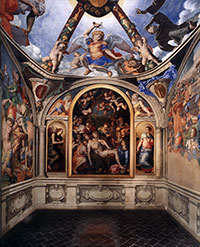
View of the Chapel of Eleonora da Toledo, 1440-45, fresco and tempera, size of the chapel 4,9 x 3,8 m, Palazzo Vecchio, Florence |
Salone Dei Cinquecento
|
With the growth of his stature and cultural ambitions when he was compiling and writing his book, the Lives of the Artists, the nature of Vasari's commissions fundamentally altered in the final thirty years of his life, from individual works such as altarpieces to grand enterprises in different media requiring a controlling hand over a large body of assistants. To accomplish these great projects he organized a vast workshop on a scale unprecedented in Florence.
The best example of the grand enterprises are the ceiling and walls of the main room, the Sala del Cinquecento, completed 1565. The ceiling is divided into 39 panels depicting episodes from the history of Florence and the Grand-duchy of Tuscany. Along the upper part of the walls are battle scenes by Vasari, below are a series of statues and marble groups.
|
|
Salone Dei Cinquecento
|
The massive Salone dei Cinquecento (Room of the Five Hundred) once held the Council of the Five Hundred, a governing body created by Savonarola during his short stint in power. The long room is largely decorated with works by Giorgio Vasari, who orchestrated the redesign of the room in the mid-16th century. It contains an ornate, coffered and painted ceiling, which tells the story of the life of Cosimo I de' Medici, and, on the walls, gigantic depictions of battle scenes of Florence's victories over rivals Siena and Pisa.
Leonardo da Vinci and Michelangelo were initially commissioned to produce works for this room, but those frescoes have been "lost." It is believed that Leonardo's Battle of Anghiari frescos still exist beneath one wall of the room. Michelangelo's Battle of Cascina drawing, which had also been commissioned for this room, was never realized on the walls of the Salone dei Cinquecento, as the master artist was called to Rome to work on the Sistine Chapel before he could begin work in the Palazzo Vecchio. But his statue Genius of Victory located in a niche at the southern end of the room is worth a look. |
|
|
|
Giorgio Vasari | Salone Dei Cinquecento, ceiling decoration
|
|
|
|
Giorgio Vasari, Salone Dei Cinquecento, ceiling decoration, completed 1565, oil on canvas, Palazzo Vecchio, Florence
|
Vasari had a well disciplined army of assistants, and with their aid he was able to cover numerous Florentine and Roman walls and ceilings with frescoes and oil paintings. While these are often unreal and pompous, they seldom lack decorative effect or historical interest. Enormous altarpieces from his studio line the side aisles of Florentine churches, vast battle scenes and smaller decorative works fill the halls and smaller chambers of the Palazzo Vecchio. In the centre the scene of Cosimo's Return from Exile in 1434 is depicted, while other episodes from the life of Cosimo the Elder are around.
The decoration of large halls with the deeds of the nobility and their ancestors was intended to inspire the viewer's admiration. The depiction of such events from the recent past has a long tradition. Most such cycles in the first half of the sixteenth century, however, are dedicated to a single person or event. By contrast, from the middle of the century onward this genre was increasingly devoted to the representation of dynasties. The first steps in this direction were taken by a family that did not belonged to the old aristocracy, but knew enough to exploit skillfully the memory of its ancestors for propaganda purposes - namely the Medici in Florence during the years of that city's transition from a republic to a principate. Duke Cosimo I openly exploited the depiction of the history of the older Medici in the Palazzo Vecchio to justify his own position. This decoration occupied Vasari and his workshop from 1556 to 1571, with interruptions, and its final version comprised more than a hundred individual depictions of historical themes.
|
|

Giorgio Vasari, Allegory of San Giovanni Valdarno, Palazzo Vecchio Museum, sala Salone dei Cinquecento, Florence |
Decoration of the Sala del Gigli
|
|
Decoration of the Sala del Gigli, 1482-84, fresco, Palazzo Vecchio, Florence
|
After his successful interlude in Rome in 1482, Ghirlandaio received the official commission from the Signoria, the city government, to produce the decorations in the Sala dei Gigli in the town hall, the Palazzo Vecchio. Sandro Botticelli, Perugino and Piero del Pollaiolo had also been assigned to the task, but only Domenico accomplished the undertaking.
The most important consideration in the Sala dei Gigli was that the overall effect had to be magnificent, and the purpose of the monumental public work was to express the pride of the city and Republic of Florence.
Ghirlandaio divided one wall by means of painted pilasters, with three arches between them. The two outer arches are over a doorway and a blind window. The result is that the entire wall appears as a mighty triumphal arch. In the centre is St Zenobius, the patron saint of Florence, with two saintly deacons. In the tympanum above the bishop is a terracotta relief of the Madonna and angels, a work similar to many that were produced by the workshop of the Della Robbia family of artists. In the background on the left there is a view of Florence Cathedral. Under the side arches stand historical characters who embody civic and republican virtues. In these figures Ghirlandaio produced very detailed variations of Roman armor and the classical contrapposto postures, features portrayed with considerable archeological accuracy.
In the Sala dei Gigli the pictorial scheme is grandiose and the ancient figures depicted in the higher part of the fresco have an extraordinary energy. The deacons in the centre, on the other hand, are weak, rather limp and monotonous, even in the colours, which have lost their original brightness and lustre.
This work is not of a high quality. Already occupied with the Sassetti Chapel, which probably gave him more satisfaction, in the Sala dei Gigli he probably traced the outline of the painting only, leaving a large part of its execution to assistants.
|
|
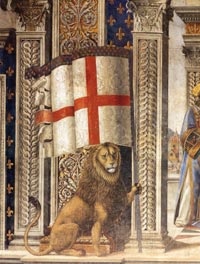
The picture shows the Marzocco, Florence's heraldic lion, with the banner of the popolo fiorentino. |
In addition to his two brothers David and Benedetto, and his brother-in-law Bastiano Mainardi, there were many other assistants: Bartolomeo di Giovanni, Francesco Granacci and Biagio d'Antonio di Firenze. It is impossible to attribute the responsibility to this or that assistant for the inferior parts of Ghirlandaio's fresco cycles, since he was also responsible for the parts that lack the animated style, vitality and mastery of colour that were present in others. From these sometimes considerable discrepancies we must form a judgement about his work that makes him at once a marvellous interpreter of people and situations, a calm, almost monotonous narrator, or a tired and empty artist at times in search of the best, at others yielding to a commonplace routine.
|
The Uffizi Gallery| Galleria degli Uffizi
|
| The Galleria degli Uffizi is propably the finest picture gallery in Italy. The gallery is housed in what were once government offices (uffizi) built by Vasari for Cosimo I in 1560. But the collection was started in 1574 when Cosimo's son, Francesco I, transformed the second floor of the Vasarian building into a place 'to walk in with paintings, sculptures and other precious things' and entrusted Buontalenti with the creation of a Tribune where art objects could be exhibited.
It makes sense to limit your initial tour to the first fifteen rooms, where the Florentine Renaissance works are concentrated, and to explore the rest another time.
Galleria degli Uffizi
Postal & visiting address: Piazzale degli Uffizi, I-50122 Florence (Firenze)
Web | www.uffizi.firenze.it
Museum Hours
Open Tuesday through Sunday, 8:15am – 6:50pm
Closed: every Monday, January 1, May 1, December 25
You can bypass the hours-long ticket line at the Uffizi Galleries by reserving a
ticket and an entry time in advance by calling Firenze Musei at & 055-294-
883 (Mon–Fri 8:30am–6:30pm; Sat until 12:30pm) or visiting www.firenze
musei.it.
All of Florence’s state-run museums belong to an association called Firenze Musei
(www.firenzemusei.it), which sets aside a daily quota of tickets. The Uffizi, the Accademia and the Bargello belong to this group, as do the Palazzo Pitti museums (including the Bóboli gardens), the Medici chapels in SanLorenzo, the archeological museum and the San Marco museum.
More info and floorplan of the Uffizi Gallery see
Florence | Galleria degli Uffizi
A door on the west corridor, between rooms 25 and 34, opens onto the Corridoio Vasariano, a passageway built by Vasari in 1565 to link the Palazzo Vecchio to the Palazzo Pitti, via the Uffizi.
|
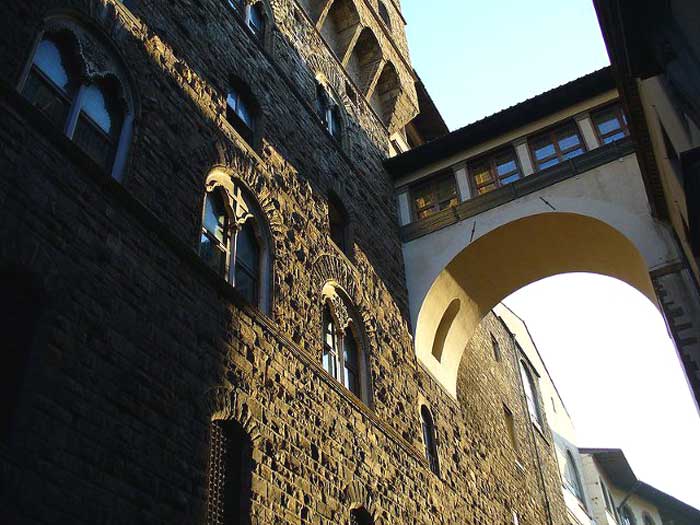 |
Vasari corridor from Palazzo Vecchio to Uffizi
|
The Vasari Corridor, that also is called the Prince's Way, for a good three centuries was to remain a private passage for Medici and Habsburg-Lorraine Grand Dukes.
|
The Vasari Corridor
|
The Corridoio Vasariano was built in 1565 by Giorgio Vasari and links the Palazzo Vecchio to the Palazzo Pitti, via the Uffizi. This private elevated walkway, also known as Percorso del Principe (“Prince’s Route”), allowed members of the Medici family to move between their residences without having to step into the street below and mix with the crowds.
Winding its way down to the river, over the Ponte Vecchio, through the church of Santa Felìcita and into the Giardino di Bóboli, it gives a fascinating series of clandestine views of the city. As if that weren’t pleasure enough, the corridor is lined with paintings, the larger portion of which comprises a gallery of self-portraits, featuring such greats as Andrea del Sarto, Bronzino, Bernini, Rubens, Velázquez, David, Delacroix and Ingres.
Tuscany | Florence | The Vasari Corridor
|
Enlarge map |
|
|
| |
|

The Florentine Civic Museums | The task of the Florentine Civic Museums is to conserve and enhance the city’s art heritage, making it available for public enjoyment in the broadest and most democratic manner possible. They represent a public service, with cultural and social functions, and a right of the citizens.
The Florentine Civic Museums are made up of a wealth and exceptional variety of collections mostly housed in ancient buildings: the Museum of Palazzo Vecchio, the Museum of Santa Maria Novella, the Firenze Com’era museum in the convent of the Oblates, the Fondazione Salvatore Romano in the refectory of Santo Spirito, and the Museo Stefano Bardini that reopened in the Oltrarno district in April 2009 after 10 years’ work of renovation and rearrangement.
Palazzo Vecchio - Musei civici fiorentini - Official site | www.museicivicifiorentini.it
GOOGLE ART PROJECT
Il Museo di Palazzo Vecchio partecipa all'Art Project del Google Cultural Institute. Scopri il progetto
Damien Wigny, Au coeur de Florence : Itinéraires, monuments, lectures, 1990
Kunst in Toscne | Historische beelden op de Piazza della Signoria, Firenze | Le statue di Piazza della Signoria, Firenze
|
 |
|
 |
|
 |
Loggia dei Lanzi, Piazza della Signoria
|
|
Fontana del Nettuno. In questa foto vediamo davanti a Nettuno, la scultura centrale nella fontana, vediamo il marzocco
|
|
Hercules en Cacus (Baccio Bandinelli) en de Loggia dei Lanzi, -
|

[0] The Palazzo Vecchio was originally called the Palazzo dei Priori Novo (New Palace of the Priors) after the ruling body (Priori) of the Florentine Commune. Built beginning in 1299, it provided a location for the ruling body that was equal to the importance of Florence, then the most powerful and wealthy city in the West. Before its construction, the Priori met in a house behind a church, not exactly a location of grandeur suitable for the Florentine Priori.
'After the battle of Montaperti in 1260, when the Ghibellines (who supported the Holy Roman Emperor) defeated the Florentine Guelphs (who supported the Pope), the Ghibellines in Florence led by the Uberti clan restored the old institutions and destroyed the palazzos, houses and towers of their Guelph enemies. When the Guelphs recovered control over the city six years later, they destroyed the palaces and homes of the Uberti clan and permanently banished them from the city, leaving their homes in rubble for many years. Finally, the Florentines cleared the rubble, bought up surrounding homes and towers, and built Piazza della Signoria and Palazzo Vecchio on the ruins of the Palazzo dei Fanti and the Palazzo dell’Esecutore di Giustizia (Executor of Justice), to ensure that the Uberti would never return to Florence (they had completely erased the Uberti clan’s ancestral homes, castles and property). They also decreed that no building would ever again stand in the accursed space occupied by the Uberti properties, which is why the Palazzo Vecchio is not centered in the Piazza, as would normally be expected (it is on the edge).'[Architecture and Art of the Palazzo Vecchio (Old Palace)]
[1] 'To this day, the squares characterize the appearance of Florence. From a historical perspective, their development was linked to various factors. Thus the Piazza and Palazzo della Signoria became a centre of political authority to counterbalance the ecclesiastic power at the cathedral. Smaller squares emerged in front of the main churches and at road junctions. The large forecourts of the converts that settled outside the second city wall brought a new type of square along during the formidable rise of the mendicant orders in the 13th century – they all formed spaces of religious, social, economic and cultural life from this point on. During the Renaissance, the targeted structuring of urban space became a central focus of architecture: The most famous example of this is the Piazza della Santissima Annunziata with Brunelleschi’s portico. This and other Florentine squares were common motifs in print reproductions. In character, some of the views shown here go back to the series of etchings from Giuseppe Zocchi’s “Scelta di XXIV Vedute”, which appeared in 1744 and enjoyed huge success. '
Kunsthistorisches Institut in Florenz | Squares
Address: Kunsthistorisches Institut in Florenz – Max-Planck-Institut, Via Giuseppe Giusti 44, 50121 Firenze
[2] Girolamo Savonarola (21 September 1452 – 23 May 1498) was an Italian Dominican friar, Scholastic, and an influential contributor to the politics of Florence from 1494 until his execution in 1498. He was known for his book burning, destruction of what he considered immoral art, and what he thought the Renaissance—which began in his Florence—ought to become. He preached vehemently against the moral corruption of much of the clergy at the time. His main opponent was Rodrigo Borgia, who was Pope Alexander VI from 1492, through Savonarola's death in 1498.
After Charles VIII of France invaded Florence in 1494, the ruling Medici were overthrown and Savonarola emerged as the new leader of the city, combining in himself the role of leader and priest. He set up a republic in Florence. Characterizing it as a “Christian and religious Republic,” one of its first acts was to make sodomy, previously punishable by fine, into a capital offence. Homosexuality had previously been tolerated in the city, and many homosexuals from the elite now chose to leave Florence. His chief enemies were the Duke of Milan, Ludovico Sforza, and Pope Alexander VI, who issued numerous restraints against him, all of which were subsequently ignored.
In 1497, he and his followers carried out the Bonfire of the Vanities. They sent boys from door to door collecting items associated with moral laxity: mirrors, cosmetics, lewd pictures, pagan books, immoral sculptures (which he wanted to be replaced by statues of the saints and modest depictions of biblical scenes), gaming tables, chess pieces, lutes and other musical instruments, fine dresses, women’s hats, and the works of immoral and ancient poets, and burnt them all in a large pile in the Piazza della Signoria of Florence.[2] Many fine Florentine Renaissance artworks were lost in Savonarola’s notorious bonfires — including paintings by Sandro Botticelli, which he is alleged to have thrown into the fires himself.[3]
Florence soon became tired of Savonarola because of the city’s continual political and economic miseries partially derived from Savonarola's opposition to trading and making money. When a Franciscan preacher challenged him to a trial by fire in the city centre and he declined, his following began to dissipate.
During his Ascension Day sermon on May 4, 1497, bands of youths rioted, and the riot became a revolt: dancing and singing taverns reopened, and men again dared to gamble publicly.
On May 13, 1497, Savonarola was excommunicated by Pope Alexander VI, and in 1498, Alexander demanded his arrest and execution. On April 8, a crowd attacked the Convent of San Marco. In the ensuing struggle, several of Savonarola’s guards and religious supporters were killed. Savonarola surrendered along with Fra Domenico da Pescia and Fra Silvestro, his two closest associates. Savonarola was charged with heresy, uttering prophecies, sedition, and other crimes, called religious errors by the Borgia pope.
During the next few weeks all three were tortured on the rack, the torturers sparing only Savonarola’s right arm in order that he might be able to sign his confession. All three signed confessions, Savonarola doing so sometime before May 8. On that day he completed a written meditation on the Miserere mei, Psalm 50, entitled Infelix ego, in which he pleaded with God for mercy for his physical weakness in confessing to crimes he believed he did not commit. On the day of his execution, May 23, 1498, he was still working on another meditation, this one on Psalm 31, entitled Tristitia obsedit me.[4]
On the day of his execution he was taken out to the Piazza della Signoria along with Fra Silvestro and Fra Domenico da Pescia. The three were ritually stripped of their clerical vestments, degraded as "heretics and schismatics", and given over to the secular authorities to be burned. The three were hanged in chains from a single cross and an enormous fire was lit beneath them. They were thereby executed in the same place where the Bonfire of the Vanities had been lit, and in the same manner that Savonarola had condemned other criminals during his own reign in Florence.
Jacopo Nardi, who recorded the incident in his Istorie della città di Firenze, wrote that his executioner lit the flame exclaiming, “The one who wanted to burn me is now himself put to the flames.” Luca Landucci, who was present, wrote in his diary that the burning took several hours, and that the remains were several times broken apart and mixed with brushwood so that not the slightest piece could be later recovered, as the ecclesiastical authorities did not want Savonarola’s followers to have any relics for a future generation of the rigorist preacher they considered a saint. The ashes of the three were afterwards thrown in the Arno beside the Ponte Vecchio.[5]
Nevertheless, the Frateschi party and her governo popolare revived until July 1499, when the French occupation of Milan began to favour it again. It was not until 1512 that the Medici returned with Spanish help, following the latest decline of the French
[3] Source: www.wga.hu
|

Podere Santa Pia is an ideal holiday house, perfect for relaxing and enjoying the splendor of the Maremma hills that rise up from southern Tuscany. Podere Santa Pia offers a panoramic tour of the valleys that surround the farmhouse, so that the trip becomes a unique experience among the colors and atmospheres of this unique Tuscan landscape.
The country house comprises approximately 450 sqm of splendid main house, 1 hectare of land overlooking the entire valley and situated in the middle of 2.000 hectares of unspoiled land.
Enjoy the exquisite art, museums and churches in the nearby cities, then relish the cuisine and epic countryside. Podere Santa Pia highlights the best of the quintessential Italian region.
Tuscan Holiday houses | Podere Santa Pia
|
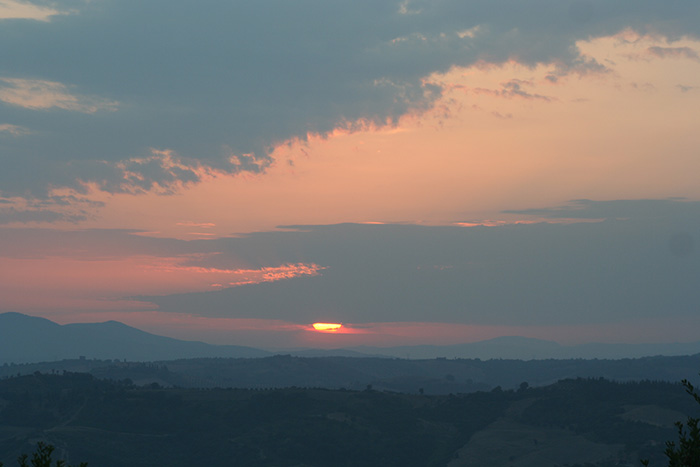 |
Podere Santa Pia, with a stunning view over the Maremma and Montecristo
|
| |
|
|
|
|
|
|
|
|
|
|
Podere Santa Pia |
|
Podere Santa Pia, garden |
|
Montecristo, view from Santa Pia
|
 |
|
|
|
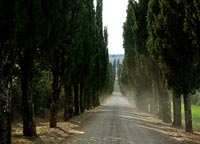 |
Sant'Antimo, between Santa Pia and Montalcino |
|
Palazzo Medici Riccardi, Florence |
|
Villa Arceno gardens |
| |
|
|
|
|
| |
|
|
|
|
Palazzi a Firenze / Palaces in Florence | Palazzo Acciaiuoli, Palazzo Adorni Braccesi, Palazzo degli Alessandri, Palazzo dell'Antella, Palazzo Antinori, Palazzo Arcivescovile, Palazzo dell'arte dei Beccai, Palazzo dell'Arte dei Giudici e Notai, Il Bargello, Palazzo Bartolini Salimbeni, Palazzo de' Benci, Palazzo di Bianca Cappello, Palazzo Buondelmonti, Palazzo dei Canonici, Palazzo Capponi Covoni, Palazzo Cocchi-Serristori, Palazzo dei Congressi, Palazzo Corsini, Palazzo Corsini al Prato, Villa Corsini a Castello, Palazzo Da Cintoia, Palazzo della Gherardesca, Palazzo Fenzi, Palazzo dei Frescobaldi, Palazzo Galileo, Palazzo Gondi, Palazzo Lenzi (French Consulate), Palazzo Giugni, Palazzo Guadagni, Palazzina della Livia, Palazzo Malenchini-Alberti, Palazzo Medici-Riccardi, Palazzo Mellini Fossi, Palazzo della Misericordia, Palazzo della Missione, Palazzo dei Mozzi, Palazzo Nasi, Palazzo Nonfinito, Palazzo Pandolfini, Palazzo Pazzi, Villa la Petraia, Palazzo Pitti, Palazzo Portinari Salviati, Palazzo delle Poste Centrali, Palazzo Pucci, Palazzo Ramirez de Montalvo, Palazzo Ricasoli, Palazzo Rucellai, Palazzo Sacrati (Guadagni-Strozzi di Mantova), Casino Salviati, Palazzo di San Clemente, Palazzetto Serragli, Palazzo Serristori, Palazzo Spini Feroni, Palazzo Strozzi, Palazzo Taddei, Palazzo Torrigiani Del Nero, Palazzo Uguccioni, Palazzo di Valfonda, Palazzo Vecchio, Villa il Ventaglio, Palazzo dei Visacci, Palazzo Vivarelli Colonna
|
|
|
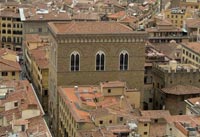 |
|
 |
Orvieto, Duomo |
|
Florence, Orsanmichele |
|
Florence, Duomo Santa Maria del Fiore |
| |
|
|
|
|
| |
|
|
| |
|
|
|
| |
|
|
|
| |
|
|
|
| |
|
|
|
| |
|
|
|
| |
|
|
|
![]()
![]()
![]()
![]()
![]()











